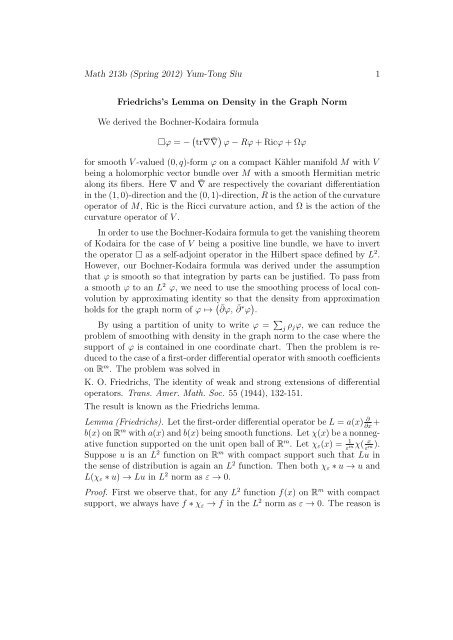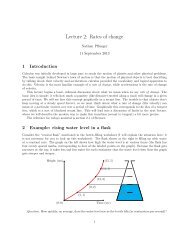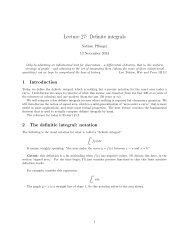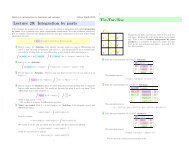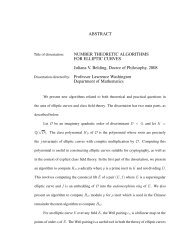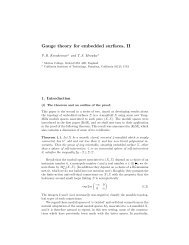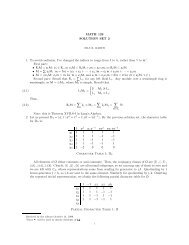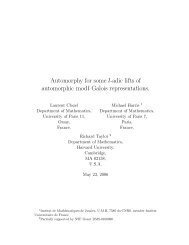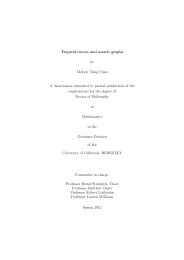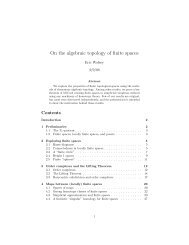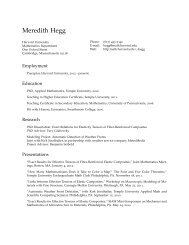Friedrichs's Lemma on Density in the Graph Norm
Friedrichs's Lemma on Density in the Graph Norm
Friedrichs's Lemma on Density in the Graph Norm
You also want an ePaper? Increase the reach of your titles
YUMPU automatically turns print PDFs into web optimized ePapers that Google loves.
Math 213b (Spr<strong>in</strong>g 2012) Yum-T<strong>on</strong>g Siu 1<br />
Friedrichs’s <str<strong>on</strong>g>Lemma</str<strong>on</strong>g> <strong>on</strong> <strong>Density</strong> <strong>in</strong> <strong>the</strong> <strong>Graph</strong> <strong>Norm</strong><br />
We derived <strong>the</strong> Bochner-Kodaira formula<br />
□φ = − ( tr∇ ¯∇ ) φ − Rφ + Ricφ + Ωφ<br />
for smooth V -valued (0, q)-form φ <strong>on</strong> a compact Kähler manifold M with V<br />
be<strong>in</strong>g a holomorphic vector bundle over M with a smooth Hermitian metric<br />
al<strong>on</strong>g its fibers. Here ∇ and ¯∇ are respectively <strong>the</strong> covariant differentiati<strong>on</strong><br />
<strong>in</strong> <strong>the</strong> (1, 0)-directi<strong>on</strong> and <strong>the</strong> (0, 1)-directi<strong>on</strong>, R is <strong>the</strong> acti<strong>on</strong> of <strong>the</strong> curvature<br />
operator of M, Ric is <strong>the</strong> Ricci curvature acti<strong>on</strong>, and Ω is <strong>the</strong> acti<strong>on</strong> of <strong>the</strong><br />
curvature operator of V .<br />
In order to use <strong>the</strong> Bochner-Kodaira formula to get <strong>the</strong> vanish<strong>in</strong>g <strong>the</strong>orem<br />
of Kodaira for <strong>the</strong> case of V be<strong>in</strong>g a positive l<strong>in</strong>e bundle, we have to <strong>in</strong>vert<br />
<strong>the</strong> operator □ as a self-adjo<strong>in</strong>t operator <strong>in</strong> <strong>the</strong> Hilbert space def<strong>in</strong>ed by L 2 .<br />
However, our Bochner-Kodaira formula was derived under <strong>the</strong> assumpti<strong>on</strong><br />
that φ is smooth so that <strong>in</strong>tegrati<strong>on</strong> by parts can be justified. To pass from<br />
a smooth φ to an L 2 φ, we need to use <strong>the</strong> smooth<strong>in</strong>g process of local c<strong>on</strong>voluti<strong>on</strong><br />
by approximat<strong>in</strong>g identity so that <strong>the</strong> density from approximati<strong>on</strong><br />
holds for <strong>the</strong> graph norm of φ ↦→ (¯∂φ, ¯∂∗ φ ) .<br />
By us<strong>in</strong>g a partiti<strong>on</strong> of unity to write φ = ∑ j ρ jφ, we can reduce <strong>the</strong><br />
problem of smooth<strong>in</strong>g with density <strong>in</strong> <strong>the</strong> graph norm to <strong>the</strong> case where <strong>the</strong><br />
support of φ is c<strong>on</strong>ta<strong>in</strong>ed <strong>in</strong> <strong>on</strong>e coord<strong>in</strong>ate chart. Then <strong>the</strong> problem is reduced<br />
to <strong>the</strong> case of a first-order differential operator with smooth coefficients<br />
<strong>on</strong> R m . The problem was solved <strong>in</strong><br />
K. O. Friedrichs, The identity of weak and str<strong>on</strong>g extensi<strong>on</strong>s of differential<br />
operators. Trans. Amer. Math. Soc. 55 (1944), 132-151.<br />
The result is known as <strong>the</strong> Friedrichs lemma.<br />
<str<strong>on</strong>g>Lemma</str<strong>on</strong>g> (Friedrichs). Let <strong>the</strong> first-order differential operator be L = a(x) ∂ + ∂x<br />
b(x) <strong>on</strong> R m with a(x) and b(x) be<strong>in</strong>g smooth functi<strong>on</strong>s. Let χ(x) be a n<strong>on</strong>negative<br />
functi<strong>on</strong> supported <strong>on</strong> <strong>the</strong> unit open ball of R m . Let χ ε (x) = 1 χ( x ).<br />
ε m ε m<br />
Suppose u is an L 2 functi<strong>on</strong> <strong>on</strong> R m with compact support such that Lu <strong>in</strong><br />
<strong>the</strong> sense of distributi<strong>on</strong> is aga<strong>in</strong> an L 2 functi<strong>on</strong>. Then both χ ε ∗ u → u and<br />
L(χ ε ∗ u) → Lu <strong>in</strong> L 2 norm as ε → 0.<br />
Proof. First we observe that, for any L 2 functi<strong>on</strong> f(x) <strong>on</strong> R m with compact<br />
support, we always have f ∗ χ ε → f <strong>in</strong> <strong>the</strong> L 2 norm as ε → 0. The reas<strong>on</strong> is
Math 213b (Spr<strong>in</strong>g 2012) Yum-T<strong>on</strong>g Siu 2<br />
as follows. From<br />
∫<br />
(f ∗ χ φ ) (x) =<br />
f(x − y)χ ε (y)dy<br />
it follows that<br />
∫<br />
(f ∗ χ φ − f) (x) =<br />
(f(x − y) − f(x)) χ ε (y)dy.<br />
By <strong>the</strong> triangle <strong>in</strong>equality and <strong>the</strong> n<strong>on</strong>negativity of χ ε ,<br />
∫<br />
∥f ∗ χ φ − f∥ L 2 = ∥f(x − y) − f(x)∥ L 2 (x) χ ε(y)dy,<br />
where ∥·∥ L 2 (x) means <strong>the</strong> L2 of <strong>the</strong> functi<strong>on</strong> of <strong>the</strong> variable x. S<strong>in</strong>ce<br />
we have f ∗ χ ε → f as ε → 0.<br />
∥f(x − y) − f(x)∥ L 2 (x)<br />
→ 0 as y → 0,<br />
S<strong>in</strong>ce Lu taken <strong>in</strong> <strong>the</strong> sense of distributi<strong>on</strong>s is assumed to be L 2 , it follows<br />
that χ ε ∗Lu → Lu <strong>in</strong> L 2 norm as ε → 0. In order to show that L(χ ε ∗u) → Lu<br />
<strong>in</strong> L 2 norm as ε → 0, it suffices to show that χ ε ∗ Lu − L(χ ε ∗ u) approaches<br />
0 <strong>in</strong> L 2 norm as ε → 0. This is clearly true when u bel<strong>on</strong>gs to <strong>the</strong> dense<br />
subset of smooth functi<strong>on</strong>s. So it suffices to show that χ ε ∗ Lu − L(χ ε ∗ u)<br />
is bounded <strong>in</strong> L 2 norm <strong>in</strong>dependently of ε when u bel<strong>on</strong>gs to a set bounded<br />
<strong>in</strong> L 2 norm. The zero-order part b(x) of L clearly has bounded c<strong>on</strong>tributi<strong>on</strong>.<br />
So we can assume without loss of generality that b(x) = 0. Then<br />
(<br />
χ ε ∗ Lu − L(χ ε ∗ u) = χ ε ∗ a ∂u )<br />
− a ∂<br />
∂x ∂x (χ ε ∗ u)<br />
= χ ε ∗ ∂<br />
(<br />
∂x (au) − χ ε ∗ u ∂a ) ( ) ∂<br />
− a<br />
∂x ∂x χ ε ∗ u<br />
( )<br />
(<br />
∂<br />
=<br />
∂x χ ε ∗ (au) − χ ε ∗ u ∂a ) ( ) ∂<br />
− a<br />
∂x ∂x χ ε ∗ u .<br />
Clearly <strong>the</strong> sec<strong>on</strong>d term <strong>on</strong> <strong>the</strong> right-hand side is bounded. So we can drop<br />
it. We have<br />
(( ) ( ))<br />
∂<br />
∂<br />
∂x χ ε ∗ (au) − a<br />
∂x χ ε ∗ u (x)
Math 213b (Spr<strong>in</strong>g 2012) Yum-T<strong>on</strong>g Siu 3<br />
∫ ( )<br />
( )<br />
∂ ∂<br />
=<br />
∂y χ ε (y)a(x − y)u(x − y) − a(x)<br />
∂y χ ε (y)u(x − y)dy<br />
∫ ( ∂<br />
=<br />
ε)<br />
∂y χ (y) (a(x − y) − a(x)) u(x − y)dy.<br />
|y|


